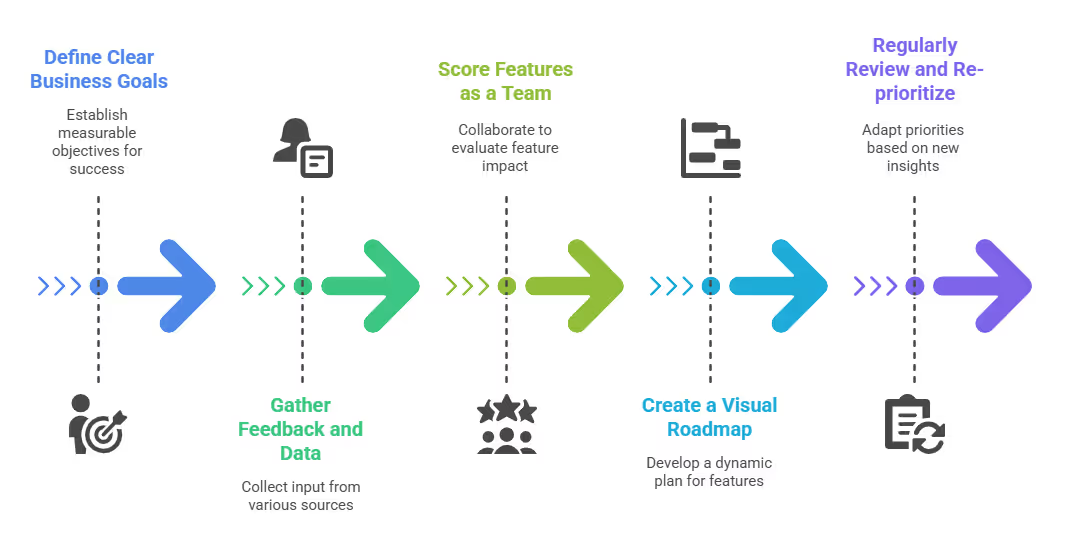Agile Prioritization Techniques | Guide for Product Managers

Agile prioritization techniques are essential tools for product managers, project leads, and agile teams who need to balance limited resources with customer demands. In today’s fast-moving U.S. software industry, deciding which features, user stories, or technical tasks to deliver first can make or break a product’s success. By applying structured prioritization methods, teams can align development with business strategy, deliver value faster, and maintain flexibility as requirements evolve. From simple scoring models to advanced frameworks like Weighted Shortest Job First (WSJF), agile prioritization helps teams focus on impact over output. This guide explores the most effective techniques used by agile practitioners to make smarter, faster decisions in product development.
Agile prioritization techniques are frameworks that help product managers, scrum masters, and development teams decide which features or tasks deliver the most value. Popular methods include MoSCoW, Kano, value vs. effort, and WSJF. These techniques ensure backlog items align with business goals, customer needs, and faster delivery in agile projects.
If you could prioritize one feature of a software product development, what it would be?
Agile, because agility itself ensures that any feature, whether customer-facing or technical, can be reprioritized quickly to match the highest value at the right time. Rather than focusing on one static feature, agile prioritization empowers teams to continuously adapt to evolving needs.
Why Agile Prioritization is a Non-Negotiable for U.S. Software Companies
In the United States, the competitive landscape for software is fierce. From consumer apps to B2B platforms, every market is crowded. This environment makes a robust prioritization strategy a competitive advantage.
It's not just about speed; it's about strategic alignment. Without a clear framework, product development can become a chaotic cycle of building what the loudest person in the room wants. This often leads to wasted resources, features that no one uses, and a product that lacks a cohesive vision.
A solid prioritization process helps teams focus on the work that truly matters. It creates a shared understanding of what "value" means and empowers every team member, from the developer to the CEO, to make informed decisions.
Common Agile Prioritization Frameworks to Master
There are many methods for prioritizing a product backlog, each with its own strengths. The key is to choose a framework that fits your team's culture and the specific project goals you have for your U.S. customers.
Here are some of the most popular and effective ones.
- MoSCoW Categorization
- Kano Model Application
- WSJF Scoring

The RICE Scoring Model for Data-Driven Decisions
The RICE framework, developed by the team at Intercom, is a quantitative method that helps teams prioritize features by scoring them on four key factors. It's particularly useful for U.S. SaaS companies that need to make data-backed decisions.
- Reach: How many people will this feature impact in a given timeframe? This is a quantifiable number (e.g., users per month, transactions per quarter).
- Impact: How much will this feature move the needle toward your goals? This is a subjective score, often on a scale (e.g., 3 for massive impact, 1 for low impact).
- Confidence: How confident are you in your estimates for Reach and Impact? This is a percentage (e.g., 90% confidence, 50% confidence).
- Effort: How many person-months will it take to complete the feature? This is a measure of the work required from your team.
The RICE score is calculated using the formula: (Reach×Impact×Confidence)/Effort. A higher score indicates a higher priority.
How to Use RICE in U.S. Software Projects:
- Product Managers use this to objectively compare a large number of feature ideas.
- Engineering Teams use the "Effort" score to provide realistic estimates and understand the workload.
- Stakeholders can see a clear, data-driven rationale behind the product roadmap, making it easier to get buy-in.
MoSCoW Method: A Simple Approach to Stakeholder Alignment
The MoSCoW method is a simple, intuitive framework that categorizes features into four distinct levels of priority. It’s an excellent choice for teams that need to quickly align with stakeholders or for projects with strict deadlines, which is common in many U.S. industries.
- Must have: These are the non-negotiable features. Without them, the product is not viable. Think of the core functionality of an e-commerce checkout process.
- Should have: Important features that add significant value but are not essential for the product’s core function. The product would still work without them, but it would be less complete.
- Could have: These are "nice-to-have" features. They are low-cost and would be a welcome addition but are only included if time and resources allow.
- Won’t have: Features that have been explicitly decided against for this release. They may be considered for future iterations, but for now, they are out of scope.
How to Use MoSCoW for U.S. Teams:
- Product Owners can use this during sprint planning to ensure the team is focused on the "Must haves."
- Client-facing Teams can use the categories to manage client expectations and provide a clear view of what’s being built now versus later.
Kano Model: Prioritizing for Customer Delight
Developed by Professor Noriaki Kano, this model is all about understanding customer satisfaction. It classifies features based on how their presence or absence affects customer sentiment. This is especially useful for companies in the U.S. focused on building a strong, loyal user base.
- Must-be Quality: Features customers expect as a bare minimum. Their absence causes dissatisfaction, but their presence doesn't create delight. (e.g., A banking app must show your account balance).
- One-Dimensional Quality: These features lead to satisfaction when present and dissatisfaction when absent. The more you have of them, the happier the customer. (e.g., Faster load times or more customization options).
- Attractive Quality (Delighters): Features that are unexpected and, when present, lead to immense satisfaction. Their absence doesn't cause dissatisfaction. (e.g., A delightful animation or a surprising bonus feature).
- Indifferent Quality: Features that have no impact on customer satisfaction, whether they are present or not.
How to Use the Kano Model for U.S. Market Penetration:
- By identifying "delighter" features, you can differentiate your product in a crowded market and create a memorable user experience.
- It helps teams avoid over-engineering "Must-be" features and instead focus resources on the "Attractive" ones that will generate buzz and positive reviews.
A Practical Guide to Implementing Agile Prioritization in Your US-based Team
Choosing a framework is just the first step. The real challenge lies in integrating it into your daily workflow.
Here is a step-by-step guide based on our experience working with companies across the United States.

1. Define Clear, Measurable Business Goals
Before you can prioritize features, you must know what success looks like. For many U.S. startups, this could be increasing user engagement by 20% or reducing customer churn. For a larger enterprise, it might be improving operational efficiency or expanding into a new market segment in the Southeast.
- Example: A logistics software company in Chicago might have a goal to "Reduce the average time to book a shipment by 15%." Every feature should be evaluated against this metric.
2. Gather and Centralize All Feedback and Data
Don't prioritize in a vacuum. Your product backlog should be a reflection of real-world needs and opportunities. This requires a continuous process of gathering input from various sources.
- Customer Feedback: Conduct user interviews, analyze support tickets, and run surveys. Tools like SurveyMonkey are widely used in the U.S. for this.
- Business Stakeholders: Get input from sales, marketing, and leadership to understand the broader business context.
- Product Analytics: Use tools like Google Analytics or Mixpanel to track user behavior and identify pain points or opportunities.
3. Score Features as a Team, Not a Single Person
Prioritization is a collaborative effort. While the Product Owner or Product Manager often owns the final decision, involving the development team and other stakeholders is crucial for building buy-in and catching blind spots.
- Tips for Collaboration: Use a virtual whiteboard tool like Miro to facilitate a scoring session. Have each team member provide their own estimates for impact or effort before coming to a consensus.
4. Create a Visual, Dynamic Product Roadmap
A static spreadsheet is a poor tool for managing a dynamic product. A visual roadmap, often managed with tools like ProductPlan or Jira, provides a single source of truth for your entire organization.
- Example: For a retail tech company in New York, a roadmap might show features organized by quarters, with each feature labeled with its RICE score and the strategic goal it supports.
5. Regularly Review and Re-prioritize
The core of agile is its adaptability. Market conditions change, new data emerges, and customer needs evolve. A feature that was a "Must have" last quarter might be a "Could have" today.
- Best Practice: Schedule a recurring meeting (e.g., every sprint or every quarter) to review the backlog and adjust priorities as needed. This ensures you’re always working on the most valuable items.
Case Study: A US-Based Fintech Startup's Prioritization Journey
We recently partnered with a rapidly growing fintech startup in Boston, Massachusetts. Their product, a wealth management platform, was struggling with a bloated backlog of feature requests from their sales team and early adopters. The development team was overwhelmed, and there was no clear consensus on what to build next.
The Challenge: Lack of a unified prioritization framework was leading to "scope creep" and missed deadlines. The team was building features based on who yelled the loudest, not on what delivered the most value.
Our Solution: We introduced the RICE scoring model. We worked with their team to define clear metrics for Reach, Impact, and Effort, and even created a custom "Confidence" metric based on user research data.
The Result: Within two sprints, the team had a clear, data-backed roadmap. They were able to push back on low-impact feature requests from sales and instead focus on a core set of features that improved user retention. This allowed them to launch a critical new module on time, leading to a 30% increase in user engagement over the next two months.
This case study is a testament to the fact that the right prioritization framework is more than a process—it’s a business driver.
Comparison of Agile Prioritization Frameworks
Choosing the right tool for the job is essential.
Here is a simple table to help U.S. product teams quickly compare frameworks.
What's Next
Mastering agile feature prioritization is a cornerstone of building successful software products in the U.S. market. It's a skill that moves you beyond simply building features and into the realm of building a valuable, user-centric product that solves real problems. By implementing frameworks like RICE, MoSCoW, or the Kano model, your team can align on what matters most and make a tangible impact.

